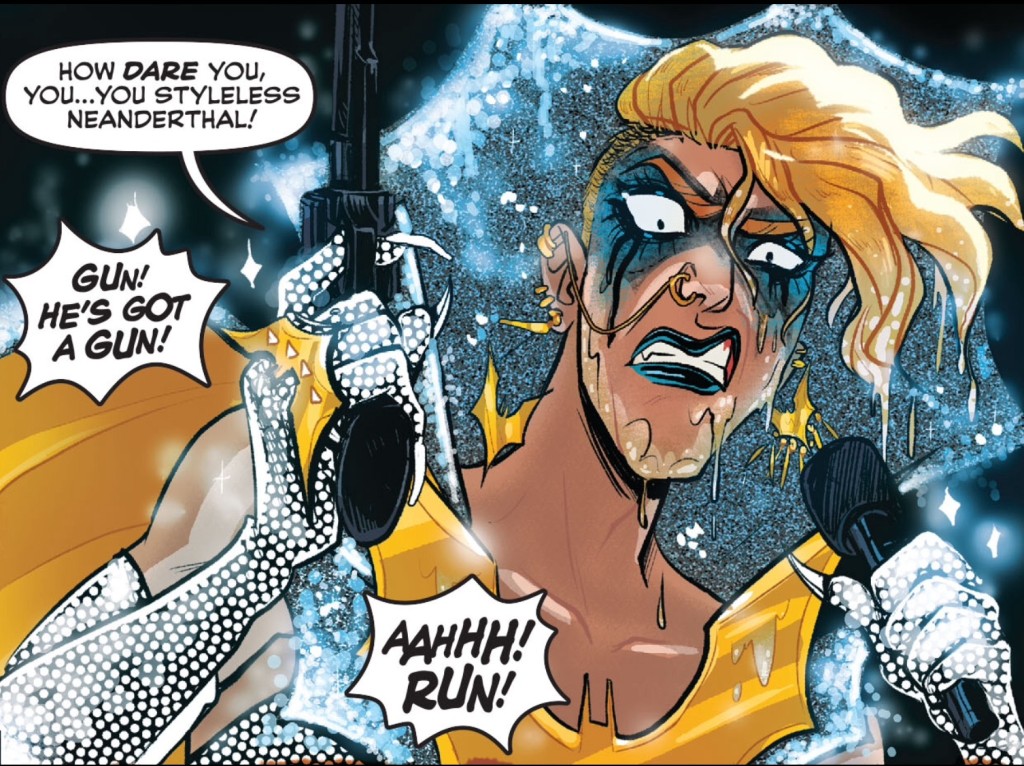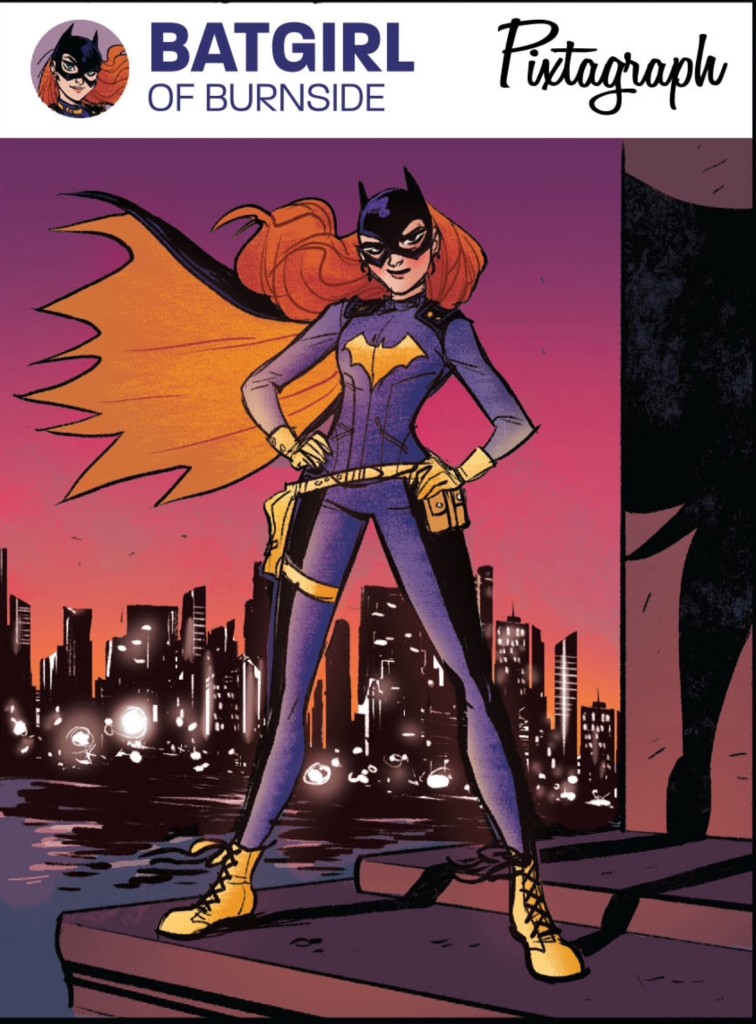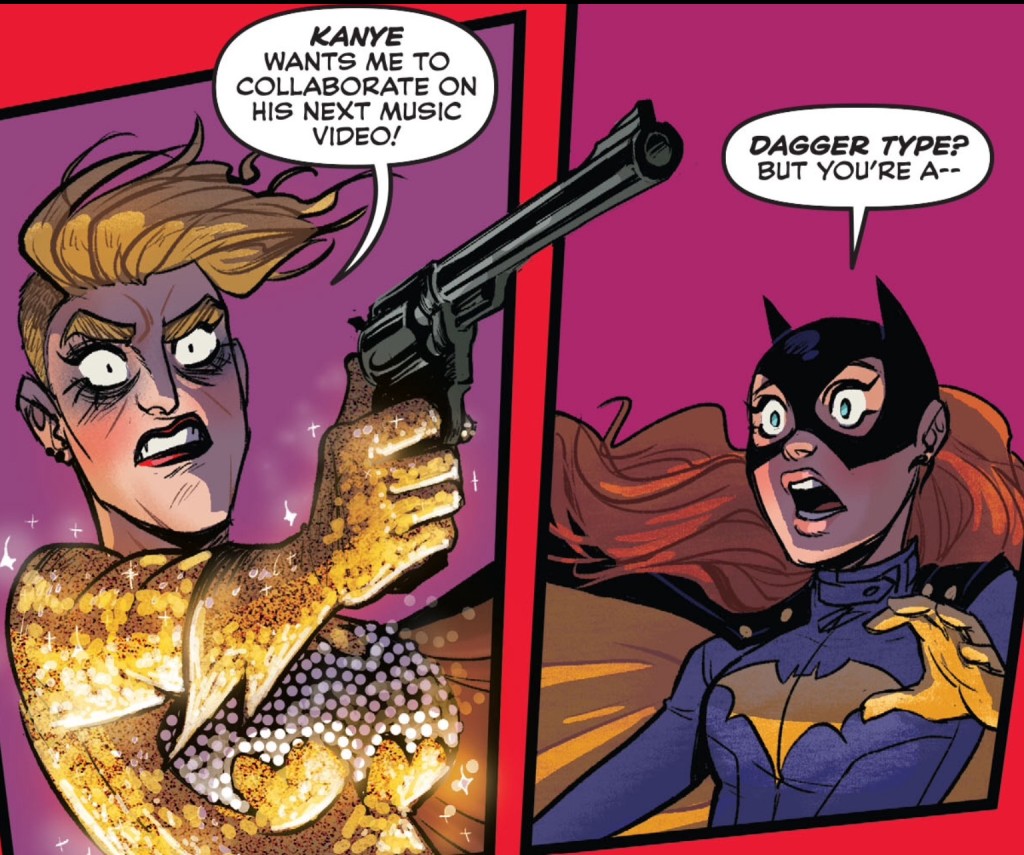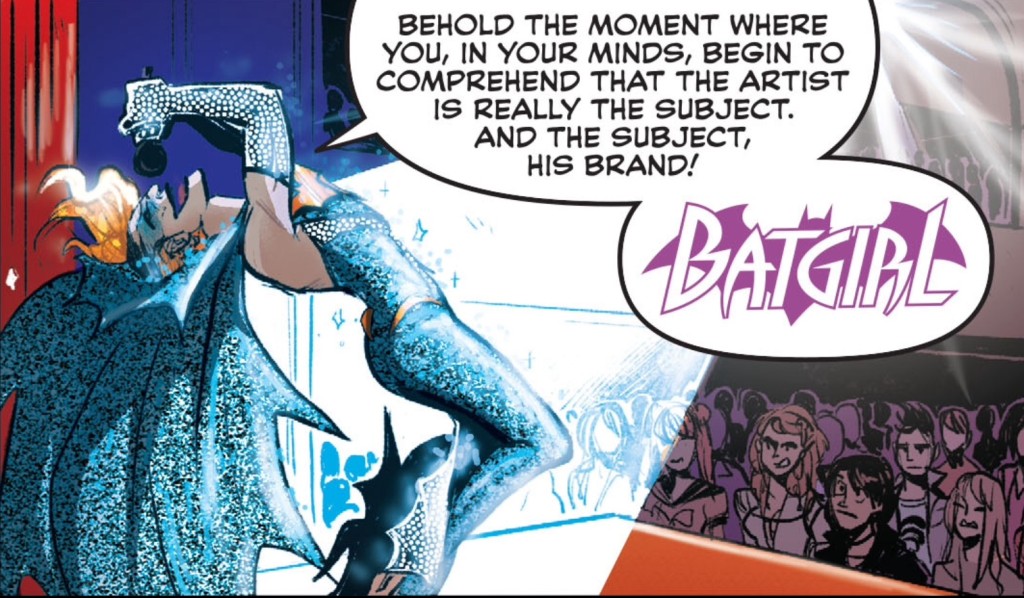 [I’m going to be talking about Batgirl #37 from soup to nuts (no pun intended), so please don’t read if you are worried about being spoiled.]
[I’m going to be talking about Batgirl #37 from soup to nuts (no pun intended), so please don’t read if you are worried about being spoiled.]
I can be a small and petty person. After being one of the only people on the planet that didn’t love Batgirl #35 and 36, the first two issues of new creative team Cameron Stewart, Brenden Fletcher, and Babs Tarr, I felt a big smug when issue #37 came out and hit a massive pothole of controversy. I’d wanted to like issues #35 and #36—really, really wanted to like it—but thought both overstuffed issues had paced things weirdly and, more troublingly, the DJ villain in the first issue seemed a bit culturally insensitive.
That insensitivity apparently amped up for their third issue, as Batgirl faced off against Dagger Type, a villainous imposter that turned out to be a man in drag believing himself to be the real Batgirl.
People were upset by the transphobia of the portrayal and a short time later, Stewart issued the following apology on Twitter:
Batgirl 37. We made mistakes. We’re deeply sorry. We will do better. pic.twitter.com/fCOEJPk0vP
— Cameron Stewart (@cameronMstewart) December 13, 2014
At the time, I’d bought the issue but had yet to read it. But I read the apology with both admiration for the way the creative team owned their mistake—this wasn’t one of those “we’re sorry if we offended anyone with delicate sensibilities” type of apologies—with a bit of the aforementioned pettiness. I thought, ‘What else could you have been intending when you set up a Batgirl imposter as a crazed man in drag, mascara running down his cheeks, waving a gun about?’

(I mean, come on. The running mascara thing is practically a trope in itself.)
Well, the other day I finally got around to reading Batgirl #37 and overall, I liked it a lot more than the previous issue. It was a little frenetic while actually having more action, more zip. And by the time I got to the end, Irealized that in fact Stewart and Team did have an entirely different set of goals with good ol’ Dagger Type and that those goals had kept them distracted from the transphobic reading of the issue.
Now, the imposter villain is an old idea (The Chameleon pops up in issue #1 of Amazing Spider-Man, back in March of 1963, and the idea was far from new back then) but Stewart & Co. are using it to slightly different ends here which is where the drag angle comes into play: from what I can tell, Batgirl #37 was crafted by Stewart and Fletcher as a clever way to address the concept of two men taking over a female led title written for over three years by a popular female creator.
Superhero comics are rife with male creators treating female characters as little more than sexualized images deprived of the depth of characterization accorded male characters. Similarly, Dagger Type appropriates Batgirl’s image with a series of glamorous photos featuring a fake Batgirl…but only Barbara herself and her friend Diana know for certain that the Batgirl in the photos is a fake. Many attending the show believe the Batgirl in the photos is the real deal, just as they believe the actions of the imposter Batgirl out in Burnside to be those of the real Batgirl. And of course, when a creative team takes over a book, not matter how out of character the lead becomes, it is “the real” Batgirl who is doing what the team has her do. At the end, as Type melts down, he bellows, “I am the real Batgirl! The only one who matters!”
Batgirl #37 was a supposed to be a lark, a laugh, where the men writing the character are aware enough of their responsibility to Batgirl and her fandom that they spoof themselves as deluded, self-important comic book creators, ones conceited enough to believe, as Dagger says, “the artist is really the subject, and the subject, his brand!”
He’s defeated (of course) and at the end of the comic Batgirl takes a photo of herself, saying “this is the way I choose to be seen.” It’s an acknowledgment and statement of intent by the creators that their revamp of the character, their difference in tone and theme from Simone’s issues, aren’t a matter of style, artistic conceit or male misappropriation: it’s a way to reframe how the character is seen, a way that is true to the conception of the character.
Of course, in doing all that, they were unaware of the other reading of the issue, the transphobic one. And while I wonder how that might have changed if someone with the right sensibilities had drawn it to their attention, I think the issue would’ve been misunderstood anyway: the Batgirl launch was lauded before it happened, a hit with the fans, so Stewart, Fletcher, and Tarr were defusing a bomb that had never been set. Even when creators and fandom are on the same page, the page is written before it’s read. As the book goes forward, I expect that even if this chapter isn’t revisited later, its lessons will remain learned.

Sigh. The art on this book is so great. Sorry I didn’t spend any time talking about how awesome you are, Babs Tarr!




Dynamite piece of writing Jeff. Your reading of both the issue and the situation brings new clarity. It’s hard to please all the people all the time, but that’s part of the fun of welcoming new audiences to the title. You gotta field the questions from the back!
While I think the creators’ intent was not to offend, I think someone should have realized running mascara, calling Batgirl “honey,” and talking about how fabulous one looks in a gaudy costume were not the best choices when using a LGBTQ character (and I am quick to point out that Dagger Type was not identified as gay’, but I feel uncomfortable using a more specific label and being wrong). Oddly enough, the Batgirl creative team has made sure that the supporting cast is made up of people from different cultures, so Dagger Type stood out as a hiccup.
Like you, I found a lot to like in this issue. I’m on board as long as Babs Tarr draws the book. I like Barbara and the other characters. The general plot was compelling even if the villain was a misstep. If they had used a female artist for Dagger Type it would have worked better. I didn’t pick up on the creator commentary that you did, so nothing would have been lost for me.
(I hate being “that guy” but the Batgirl relaunch started in issue 35. I am so sorry I didn’t stop myself from pointing that out, but nerds will be nerds.)
Mike: Thanks for being “that* guy: somehow I’d totally mooshed the first two issues of the run into one issue. I’m gonna correct that now. Again, thanks!
And I agree with your other points—the portrayal of Dagger Type is, to put it kindly, problematic.
Great review, Jeff. I’m impressed how you were able to touch on the controversy without loosing sight of, you know, the review itself. Of course, I shouldn’t have expected anything less. In this age of information blitz and immediate gratification, I never once even thought about the fact that this comic was being made likely before the new creative team was announced and not a couple days before it shipped.
You brought this up many times during your Avengers talk, and now with “Batgirl #37,” but do you think a lot of mainstream comics, i.e., Marvel and DC, creators are using their books to comment on the industry itself? I can only recall really seeing it myself with Grant Morrison comics, but he’s never really subtle about it (e.g., that one issue of “Action Comics.”) I’ll have to think about that more when I read new and old superhero comics alike.
Anyway, your reward for such a great piece is a Toyota commercial with Batman. Why Batman? The commercial asks the very same thing. The answer is because Batman is a symbol of the man who continues to fight, and the (new) Toyota Esquire continues the legacy of luxury cars. Or something. Does it matter? Batman and boxy cars–a match made in Japan!
https://www.youtube.com/watch?v=v1wBjC_cj4U
Re: Creators using comics to comment on the industry.
In this article I read (http://webcomicsdotroeng.tumblr.com/post/99175682610/superhero-comic-as-two-genres) it made the case that the basic template of a superhero story is so narrow (bad guy does a bad thing, superhero swoops in to stop them and set things right) that its hard to do something artistic with it without making a comment/critque/examination of that formula. Making a comic story which is commenting on the comics industry, while very insider-basebally, is still closer to saying something about the real world then “what if there were other different coloured lanterns”, “if Batman used a gun he wouldnt be as cool as the regular Batman”, “if violent vigilantism was outlawed it would be bad cos we wouldnt get to see people in spandex punching each other”, “there was an entirely different shadowy figure behind Wolverine origin!”
Hi there, and thanks for sharing that :). But…
is not quite what I was trying to say there. There might be a language barrier at play. Rather I was arguing that the first superhero stories (especially the Superman ones) were socially conscious by design, not by accident. And since they were crafted specifically to be, more or less, propaganda, there’s not much you can do within that framework in order to keep them going as mainstream, commercial narratives. The superhero genre became exhausted and barren.
Then with the Silver Age, atop of it grew another (more self-referential, reflexive, po-mo) genre. One whose success hinged less on its immediate narrative and narration and more on the dialog it maintained with that previous genre. I think not wholly unlike anti-war movies, acid-western or neo-noir. The difference being that they coexist within the same narrative, which makes them a lot harder to untangle.
This is a way of looking at superhero comics that makes a lot more sense to me than that classical Golden Age, Silver Age, Bronze Age, Dark Age separation.
Anyway, thanks again for sharing. I’ve never had the opportunity to discuss that essay with superhero comics readers.
I’m grateful that no “edgy white guy” has come to the comments section yet to bitch about Stewart and Fletcher caving to the “PC Police”. I’m sorry if I jinxed it by bringing it up.
Interesting review, Jeff. Like you, I wasn’t overwhelmed by the first issue – way too Bob Haney without all the great parts of Bob Haney, and the whole thing just seemed too high-concept. (Like, the device of graphically representing Barbara’s photographic memory through ghostly people and glowing settings: that would be perfect for some ten-years-ago Fox primetime drama about a forensic examiner who talks to dead people.) And like you, I took more than a little schadenfreude in the dust-up after I dropped the book – not so much for Stewart and co., who owned up to their mistake really well, but for the vocal fans who had built this mediocre comic into some kind of triumph for social justice. It was never going to live up to that standard, so better to find out quickly, I guess?
But I did have one question for you: how did you think the douchebag DJ villain in the first issue was culturally insensitive? He seemed like he was on the hook for his own behavior, not any group identification. #notalldouchebags
(PS. I’d also love to hear more about Jeff Koons and Matt Fraction sometime!)